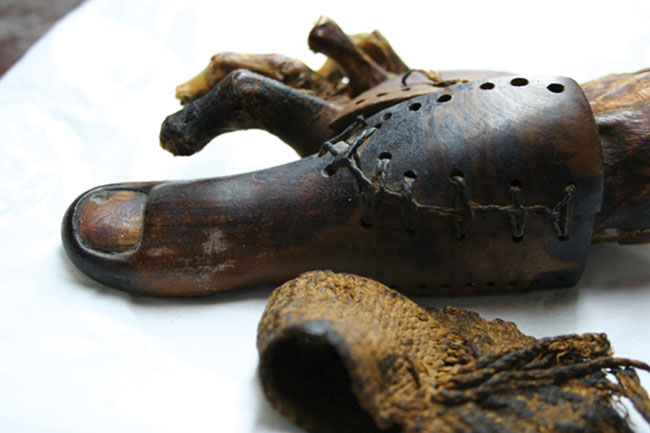World's First Prosthetic: Egyptian Mummy's Fake Toe

An artificial big toe found on the foot of an Egyptian mummy could prove to be the world's earliest functioning prosthetic body part, it was announced today. Volunteers who have lost their right big toe are now being recruited to see how effective replicas of the prosthesis are. The fake toe from the Cairo museum in Egypt was found in 2000 in a tomb near the ancient city of Thebes. Archaeologists speculated the 50- to 60-year-old woman the prosthesis came from might have lost her toe due to complications from diabetes. The wood and leather prosthesis dates from 1069 to 664 B.C., based on artifacts it was found with in the mummy's burial chamber. This means it predates what was previously thought of as the earliest known functioning prosthesis, the Roman Capua Leg, a bronze artifact dating from about 300 B.C. The leg was once at the Royal College of Surgeons in London but was destroyed by bombing during World War II. Replicas of a second false Egyptian right big toe on display at the British Museum in London, albeit without its mummy, will also be tested. This artifact, named the Greville Chester Great Toe after the collector who acquired it for the museum in 1881, is made from cartonnage, a sort of papier maché made using linen, glue and plaster. Based on the way the linen threads were spun, it dates from 1295 to 664 B.C. "If either prosthesis aids walking or balance then the history of prosthetic medicine will be pushed back some 600 to 700 years and credited to the ancient Egyptians," said researcher Jacky Finch at the University of Manchester's KNH Centre for Biomedical Egyptology in England. "If either one is functional it may be interesting to manufacture it with modern materials and trial it for use on people with missing toes." The Cairo toe is the most likely of the two to be functional, as it is jointed in three places "and shows signs of wear," Finch said. "It is still attached to the foot of the mummy of a female between 50 and 60 years of age. The amputation site is also well healed." The Greville Chester Great Toe also shows signs of wear, suggesting that it may have been worn by its owner in life and not simply attached to the foot during mummification for religious or ceremonial reasons. However, unlike the Cairo specimen, the Greville Chester Great Toe does not bend and so is likely to have been more cosmetic. The ancient Egyptians often restored artificial body parts to corpses, which means what might appear to be useful prosthetics actually were not. "The theology of Osiris, the god of the dead, stated that the body, in order to be effective during the afterlife, should be complete," Finch explained. "Osiris himself, according to myth, was cut up and his body parts scattered and later reunited." Scientists have found a variety of artificial body parts restored on mummies, including feet, legs, noses, ears—and even penises. "You were still able to procreate in the afterlife," Finch told LiveScience. To see if the toes were functional and not simply cosmetic, the researchers hope to build replicas of the toes and test them by the end of this year. Finding suitable volunteers missing their right big toes "is proving quite difficult, but we are compiling a list," Finch said.
- Top 10 Worst Hereditary Conditions
- Seven Ancient Wonders of the World
- CSI: Egypt
Sign up for the Live Science daily newsletter now
Get the world’s most fascinating discoveries delivered straight to your inbox.










